Decoding Construction Accident Causality: A Decade of Textual Reports Analyzed
Abstract
1. Introduction
- (1)
- Knowledge Traceability: LDA’s “topic–keyword” distributions map directly to construction terms. This aligns perfectly with safety construction logic.
- (2)
- Long-term Robustness: Terminology evolves in long-term datasets. LDA’s bag-of-words approach is more resilient to term changes than semi-supervised or supervised methods (like pre-trained models), which require constantly updated labeled datasets.
- (3)
- Low-Resource Needs: Labeling costs for semi-supervised or supervised methods are too high for large datasets. Graph neural networks heavily depend on accurate entity relationship extraction. These methods demand significant hardware and time. LDA, conversely, enables rapid large-scale accident type and key factor surveys with low computing resources. This makes LDA more suitable for industrial use.
2. Research Methods
2.1. Text Preprocessing
- Text Cleaning: All text was converted to lowercase. Punctuation, numbers, and special characters were removed.
- Tokenization: Text was split into individual words.
- Stop-word Removal: A standard English stop-word list from the NLTK library was used. Furthermore, a custom, domain-specific stop-word list was developed by reviewing high-frequency but low-information words in the corpus. This combined list was applied to filter out noise.
- Lemmatization: Words were reduced to their base or dictionary form using the WordNet lemmatizer from NLTK to consolidate different inflections of the same word.
- Vocabulary Pruning: The vocabulary was pruned based on document frequency. Terms that appeared in fewer than 10 documents (min_df = 10) or in more than 70% of the documents (max_df = 0.7) were excluded to remove rare terms and overly common, non-discriminatory words.
- Feature Selection with TF-IDF: The preprocessed text was vectorized using TF-IDF. The top 2000 features with the highest TF-IDF scores across the corpus were selected for the final vocabulary to reduce dimensionality and computational cost while retaining the most discriminative terms for topic modeling.
2.2. LDA Topic Modeling
2.3. LDA Result Evaluation Metrics
- Coherence
- 2.
- Perplexity
- 3.
- Mean Intertopic Distance
- 4.
- Topic Similarity
3. Case Study
3.1. Data Description
- (1)
- Reports exceeding 100 words were excluded to minimize noise and irrelevant narrative contents.
- (2)
- Reports shorter than 20 words were excluded to ensure sufficient contextual information for meaningful analysis.
3.2. Determination of the Number of Topics
- (1)
- Coherence Score: A higher score indicates better semantic coherence of the topics. The data shows that the scores fluctuate across different numbers of topics.
- (2)
- Perplexity Score: Perplexity increases with the number of topics, which is normal because more topics can capture more details in the data but also increase the model’s complexity.
- (3)
- Mean Intertopic Distances: A higher value indicates better distinction between topics.
- (4)
- Topic Similarity: This value increases with the number of topics, which might mean that the distinctions between topics become blurrier as the number of topics increases.
3.3. Results of Topic Modeling
3.4. Analysis of Characteristics of Construction Accidents
3.5. Analysis of Major Causes of the Accidents
- Input Preparation: The expert was provided with two key inputs for each of the five LDA topics:
- (1)
- The top-30 most relevant keywords (from Table 2).
- (2)
- The interpretative topic name (from Section 3.4).
- Coding Framework: The expert was instructed to map the keywords to causal factors within the predefined 4M1E (Man, Machine, Material, Method, Environments) framework. Clear definitions for each category were provided. Method encompasses management and procedural factors like training, planning, and supervision.
- Systematic Coding Process: For each topic, the expert:
- (1)
- Identified Causal Indicators: Reviewed the keyword list to identify terms that served as indicators for potential 4M1E causes. For example, in Topic 1, scaffold, ladder >Machine; fall > Man/Environment; the prevalence of such incidents > Method: Inadequate planning/training.
- (2)
- Assigned Causes: Based on the semantic meaning and contextual interpretation of these keyword clusters, the expert assigned all relevant 4M1E causes to the topic.
- (3)
- Documented Rationale: The expert documented the primary keywords justifying each cause assignment.
- (1)
- The specific causes identified for each topic.
- (2)
- Representative Keywords that formed the basis for the expert’s judgment.
- (3)
- The Frequency of Reports in each topic containing at least one of the representative keywords for a given cause. This frequency serves as a robust, data-driven indicator of the pervasiveness of each causal factor.
4. Results and Discussion
4.1. Accident Classification by Results of Topic Modeling
4.2. Accident Causal Factors Classifications
4.3. Comparison with Other Research
4.4. Practical Significance
4.5. Limitations
5. Conclusions
- (1)
- Prioritize Environmental Control: Safety management protocols and site inspections should be systematically strengthened to identify and mitigate environmental hazards. Particular attention should be paid to maintaining even and dry working surfaces, ensuring clear access routes free of obstructions, and controlling exposure to extreme weather and poor ventilation. This focus is crucial, as the physical work environment is a primary, though often less emphasized, catalyst for accidents [38]. A deeper understanding of site-specific hazards can be achieved by considering the construction typology, as different structural types present unique hazard profiles [43].
- (2)
- Strengthen Management Systems: Construction companies should critically review and enhance their management practices, with a specific focus on implementing more effective and regular safety training programs that are tailored to the specific hazards identified. They should enforce rigorous task planning and risk assessment procedures before the commencement of work, especially for high-risk activities like lifting operations and hot work. Psychosocial health hazards should be proactively managed through holistic hazard management interventions. This expands the traditional concept of safety to include worker well-being, which is crucial for sustainable accident prevention [44].
- (3)
- Leverage Data-Driven Monitoring: It is recommended that organizations integrate text mining models, such as the LDA framework demonstrated here, into their safety reporting systems. This enables the automated, real-time classification of new incident and near-miss reports, facilitating proactive risk identification and timely intervention.
Author Contributions
Funding
Data Availability Statement
Conflicts of Interest
Abbreviations
| LDA | Latent Dirichlet Allocation |
| BERT | Bidirectional Encoder Representations from Transformers |
| NLP | Natural Language Processing |
| TF-IDF | Term Frequency-Inverse Document Frequency |
References
- Xu, X.; Zou, P.X.W. Discovery of new safety knowledge from mining large injury dataset in construction. Saf. Sci. 2021, 144, 105481. [Google Scholar] [CrossRef]
- Guo, B.H.; Zou, Y.; Fang, Y.; Goh, Y.M.; Zou, P.X.W. Computer vision technologies for safety science and management in construction: A critical review and future research directions. Saf. Sci. 2021, 135, 105130. [Google Scholar] [CrossRef]
- Alkaissy, M.; Arashpour, M.; Golafshani, E.M.; Hosseini, M.R.; Khanmohammadi, S.; Bai, Y.; Feng, H. Enhancing construction safety: Machine learning-based classification of injury types. Saf. Sci. 2023, 162, 106102. [Google Scholar] [CrossRef]
- Alsharef, A.; Albert, A.; Awolusi, I.; Jaselskis, E. Severe injuries among construction workers: Insights from OSHA’s new severe injury reporting program. Saf. Sci. 2023, 163, 106126. [Google Scholar] [CrossRef]
- Baker, H.; Hallowell, M.R.; Tixier, A.J.-P. AI-based prediction of independent construction safety outcomes from universal attributes. Autom. Constr. 2020, 118, 103146. [Google Scholar] [CrossRef]
- Bugalia, N.; Tarani, V.; Kedia, J.; Gadekar, H. Machine learning-based automated classification of worker-reported safety reports in construction. J. Inf. Technol. Constr. 2022, 27, 926–950. [Google Scholar] [CrossRef]
- Chen, S.; Sun, M.; Chen, Y.; Nie, B.; Li, Z.; Liu, W. Causal analysis of construction safety accidents in hydropower projects based on unsupervised LDA. China Saf. Sci. J. (CSSJ) 2023, 33, 79–85. [Google Scholar] [CrossRef]
- Pan, X.; Zhong, B.; Sheng, D.; Yuan, X.; Wang, Y. Blockchain and deep learning technologies for construction equipment security information management. Autom. Constr. 2022, 136, 104186. [Google Scholar] [CrossRef]
- Lisboa, P.; Saralajew, S.; Vellido, A.; Fernández-Domenech, R.; Villmann, T. The coming of age of interpretable and explainable machine learning models. Neurocomputing 2023, 535, 25–39. [Google Scholar] [CrossRef]
- Gadekar, H.; Bugalia, N. Automatic classification of construction safety reports using semi-supervised YAKE-Guided LDA approach. Adv. Eng. Inform. 2023, 56, 101929. [Google Scholar] [CrossRef]
- Do, Q.; Le, T.; Le, C. Uncovering Critical Causes of Highway Work Zone Accidents Using Unsupervised Machine Learning and Social Network Analysis. J. Constr. Eng. Manag. 2024, 150, 04023168. [Google Scholar] [CrossRef]
- Feng, D.; Chen, H. A small samples training framework for deep Learning-based automatic information extraction: Case study of construction accident news reports analysis. Adv. Eng. Informatics 2021, 47, 101256. [Google Scholar] [CrossRef]
- Galassi, A.; Lippi, M.; Torroni, P. Attention in Natural Language Processing. IEEE Trans. Neural Networks Learn. Syst. 2021, 32, 4291–4308. [Google Scholar] [CrossRef] [PubMed]
- Kang, K.S.; Koo, C.; Ryu, H.G. An interpretable machine learning approach for evaluating the feature importance affecting lost workdays at construction sites. J. Build. Eng. 2022, 53, 104534. [Google Scholar] [CrossRef]
- Kim, J.; Lee, G.; Lee, S.; Lee, C. Towards expert–machine collaborations for technology valuation: An interpretable machine learning approach. Technol. Forecast. Soc. Chang. 2022, 183, 121940. [Google Scholar] [CrossRef]
- Li, X.; Zhu, R.; Ye, H.; Jiang, C.; Benslimane, A. MetaInjury: Meta-learning framework for reusing the risk knowledge of different construction accidents. Saf. Sci. 2021, 140, 105315. [Google Scholar] [CrossRef]
- Martínez-Rojas, M.; Antolín, R.M.; Salguero-Caparrós, F.; Rubio-Romero, J.C. Management of construction Safety and Health Plans based on automated content analysis. Autom. Constr. 2020, 120, 103362. [Google Scholar] [CrossRef]
- Liao, C.W.; Chiang, T.L. Occupational injuries among non-standard workers in the Taiwan construction industry. J. Saf. Res. 2022, 82, 301–313. [Google Scholar] [CrossRef]
- Qiao, J.; Wang, C.; Guan, S.; Shuran, L. Construction-Accident Narrative Classification Using Shallow and Deep Learning. J. Constr. Eng. Manag. 2022, 148, 04022088. [Google Scholar] [CrossRef]
- Shin, J.; Joung, J.; Lim, C. Determining directions of service quality management using online review mining with interpretable machine learning. Int. J. Hosp. Manag. 2024, 118, 103684. [Google Scholar] [CrossRef]
- You, K.; Zhou, C.; Ding, L. Deep learning technology for construction machinery and robotics. Autom. Constr. 2023, 150, 104852. [Google Scholar] [CrossRef]
- Liu, J.; Luo, H.; Liu, H. Deep learning-based data analytics for safety in construction. Autom. Constr. 2022, 140, 104302. [Google Scholar] [CrossRef]
- Suvorova, A. Interpretable Machine Learning in Social Sciences: Use Cases and Limitations. In Digital Transformation and Global Society; Springer: Cham, Switzerland, 2021. [Google Scholar] [CrossRef]
- Zhang, Z.; Li, Y.; Yang, S.; Zhang, Z.; Lei, Y. Code-aware fault localization with pre-training and interpretable machine learning. Expert Syst. Appl. 2024, 238, 121689. [Google Scholar] [CrossRef]
- Luo, X.; Li, X.; Goh, Y.M.; Song, X.; Liu, Q. Application of machine learning technology for occupational accident severity prediction in the case of construction collapse accidents. Saf. Sci. 2023, 163, 106138. [Google Scholar] [CrossRef]
- Farea, A.; Tripathi, S.; Glazko, G.; Emmert-Streib, F. Investigating the optimal number of topics by advanced text-mining techniques: Sustainable energy research. Eng. Appl. Artif. Intell. 2024, 136, 108877. [Google Scholar] [CrossRef]
- Wu, W.; Wen, C.; Yuan, Q.; Chen, Q.; Cao, Y. Construction and application of knowledge graph for construction accidents based on deep learning. Eng. Constr. Arch. Manag. 2025, 32, 1097–1121. [Google Scholar] [CrossRef]
- Cao, K.; Chen, S.; Yang, C.; Li, Z.; Luo, L.; Ren, Z. Revealing the coupled evolution process of construction risks in mega hydropower engineering through textual semantics. Adv. Eng. Inform. 2024, 62, 102713. [Google Scholar] [CrossRef]
- Zepeda-Martínez, D.; Guzman-Ponce, A.; Valdovinos-Rosas, R.M.; Delgado-Hernández, D.J. Pattern Recognition in Road Safety: Uncovering the Latent Causes of Accidents on Mexico’s Federal Highways. In Pattern Recognition; Springer: Cham, Switzerland, 2024. [Google Scholar] [CrossRef]
- Zhou, Y.; Liao, L.; Gao, Y.; Wang, R.; Huang, H. TopicBERT: A Topic-Enhanced Neural Language Model Fine-Tuned for Sentiment Classification. IEEE Trans. Neural Netw. Learn. Syst. 2023, 34, 380–393. [Google Scholar] [CrossRef]
- Maali, O.; Ko, C.-H.; Nguyen, P.H. Applications of existing and emerging construction safety technologies. Autom. Constr. 2024, 158, 105231. [Google Scholar] [CrossRef]
- Mostofi, F.; Toğan, V. Construction safety predictions with multi-head attention graph and sparse accident networks. Autom. Constr. 2023, 156, 105102. [Google Scholar] [CrossRef]
- Wu, Z.; Xie, P.; Zhang, J.; Zhan, B.; He, Q. Tracing the Trends of General Construction and Demolition Waste Research Using LDA Modeling Combined With Topic Intensity. Front. Public Health 2022, 10, 899705. [Google Scholar] [CrossRef]
- Wang, L. Research on the mining of ideological and political knowledge elements in college courses based on the combination of LDA model and Apriori algorithm. Appl. Math. Nonlinear Sci. 2022, 8, 2345–2356. [Google Scholar] [CrossRef]
- Sievert, C.; Shirley, K.E. LDAvis: A method for visualizing and interpreting topics. In Proceedings of the Workshop on Interactive Language Learning, Visualization, and Interfaces, Baltimore, MD, USA, 27 June 2014. [Google Scholar] [CrossRef]
- Jin, X.; Zhou, W.; Zhu, Q.; Wang, W.; Xu, G. Research on the analysis and application of technological supply and demand structure based on LDA and BERTopic models. Cogn. Robot. 2025, 5, 260–275. [Google Scholar] [CrossRef]
- Liu, Y.; Wang, J.; Tang, S.; Zhang, J.; Wan, J. Integrating Information Entropy and Latent Dirichlet Allocation Models for Analysis of Safety Accidents in the Construction Industry. Buildings 2023, 13, 1831. [Google Scholar] [CrossRef]
- Zhou, K.; Wang, J.; Ashuri, B.; Chen, J. Discovering the Research Topics on Construction Safety and Health Using Semi-Supervised Topic Modeling. Buildings 2023, 13, 1169. [Google Scholar] [CrossRef]
- Tian, D.; Li, M.; Ren, Q.; Zhang, X.; Han, S.; Shen, Y. Intelligent question answering method for construction safety hazard knowledge based on deep semantic mining. Autom. Constr. 2023, 145, 104670. [Google Scholar] [CrossRef]
- Sarkar, S.; Maiti, J. Machine learning in occupational accident analysis: A review using science mapping approach with citation network analysis. Saf. Sci. 2020, 131, 104900. [Google Scholar] [CrossRef]
- Luo, X.; Li, X.; Song, X.; Liu, Q. Convolutional Neural Network Algorithm–Based Novel Automatic Text Classification Framework for Construction Accident Reports. J. Constr. Eng. Manag. 2023, 149, 04023128. [Google Scholar] [CrossRef]
- Elvik, R. Risk factors as causes of accidents: Criterion of causality, logical structure of relationship to accidents and completeness of explanations. Accid. Anal. Prev. 2024, 197, 107469. [Google Scholar] [CrossRef]
- Suárez Muntaner, M.R.; González García, M.d.l.N.; Carpio de los Pinos, A.J. Correlation Between Construction Typology and Accident Rate—Case Study: Balearic Islands (Spain). Buildings 2025, 15, 3486. [Google Scholar] [CrossRef]
- Biggs, A.; Kellner, A.; Robertson, A.; Mason, J.; Townsend, K.; Page, S.J.; Thompson, N.; Loudoun, R. Managing Psychosocial Health Risks in the Australian Construction Industry: A Holistic Hazard Management Intervention. Buildings 2025, 15, 3475. [Google Scholar] [CrossRef]
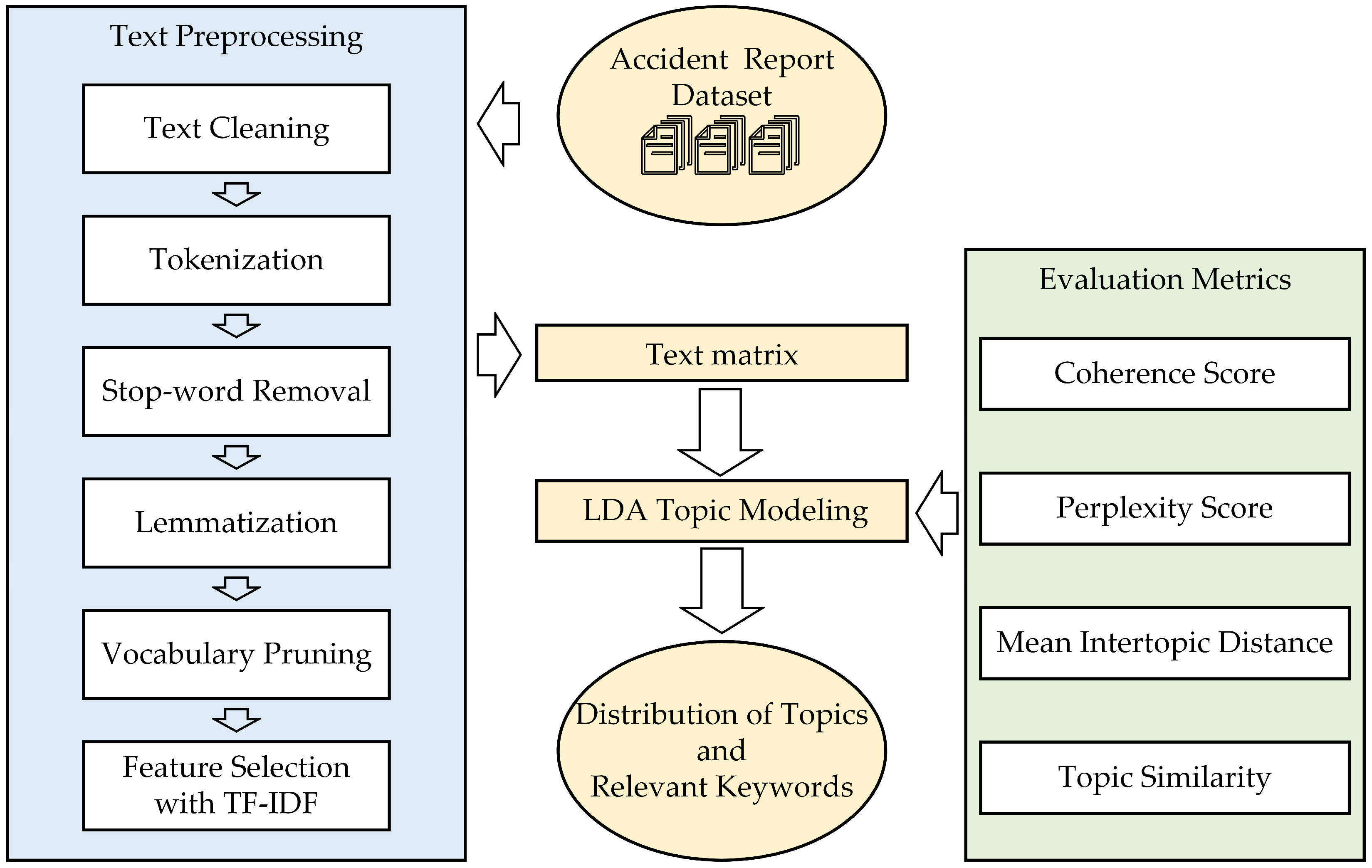
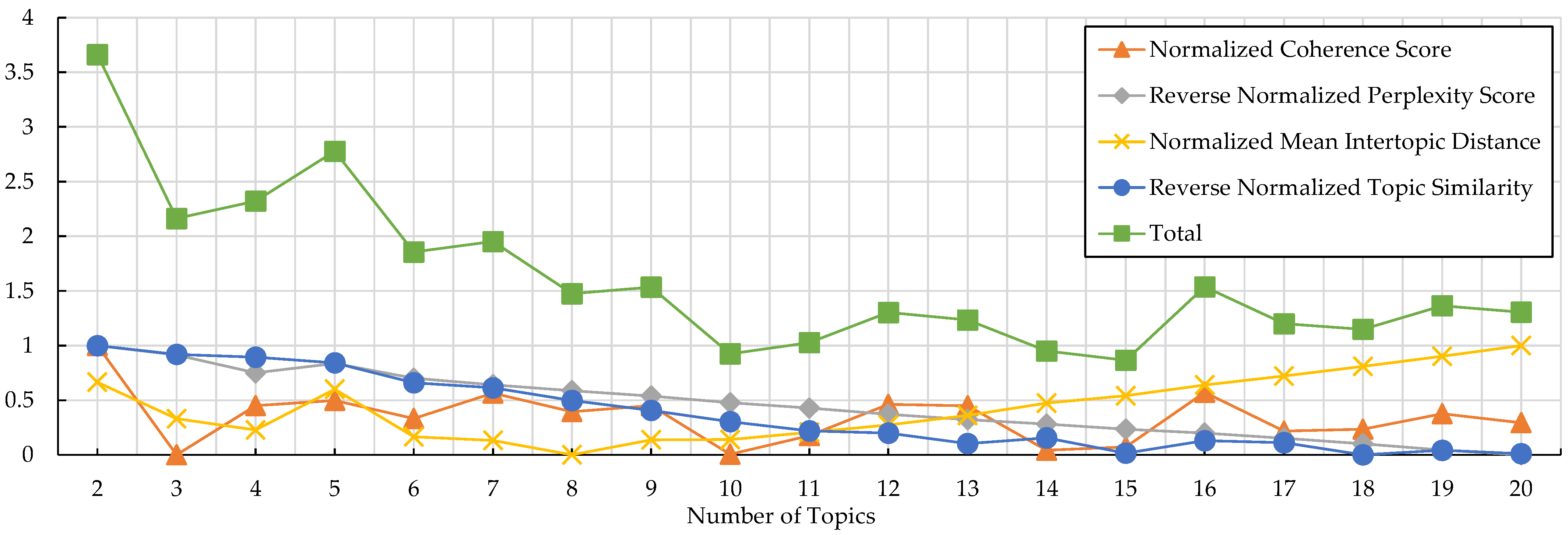
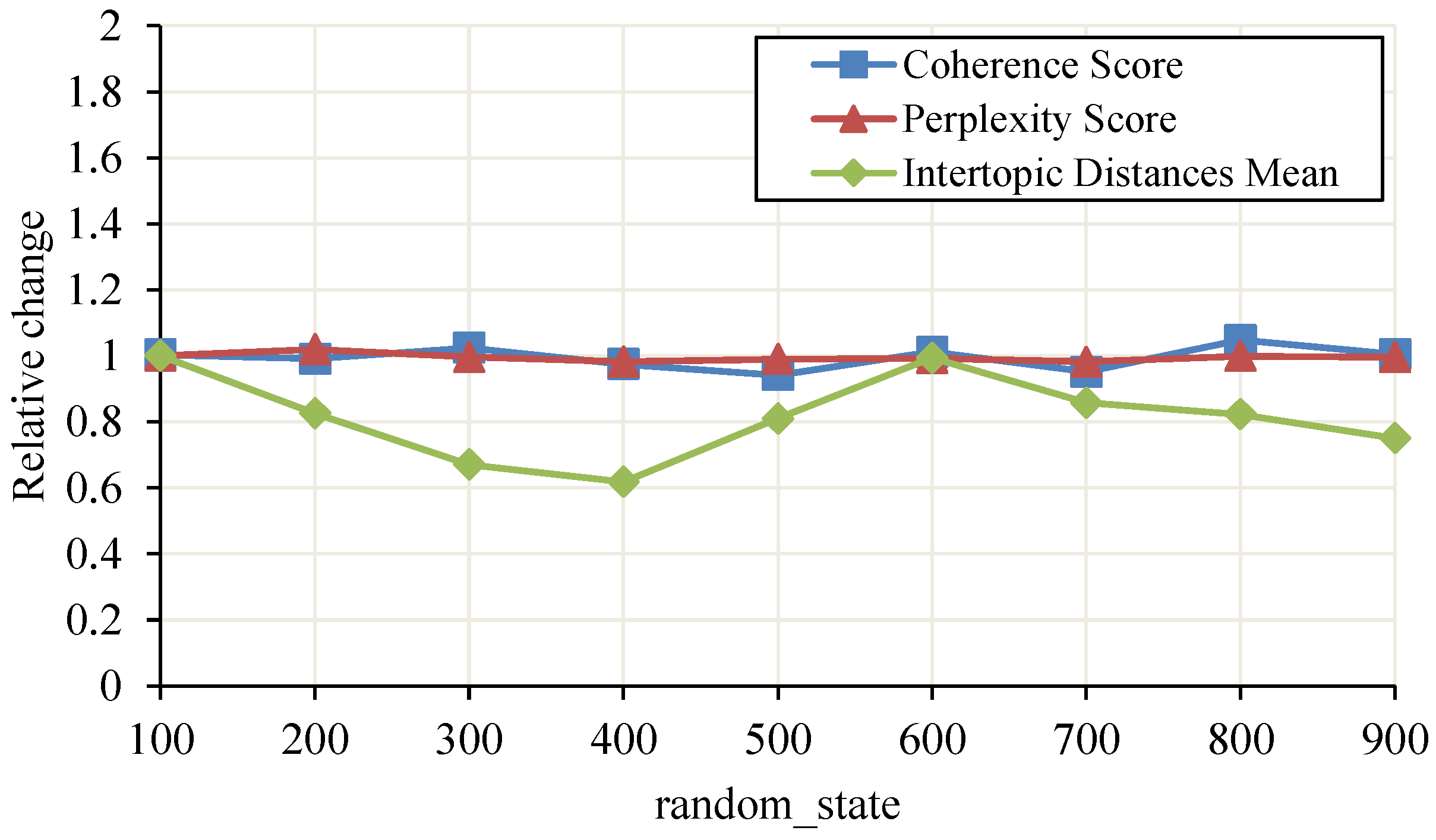
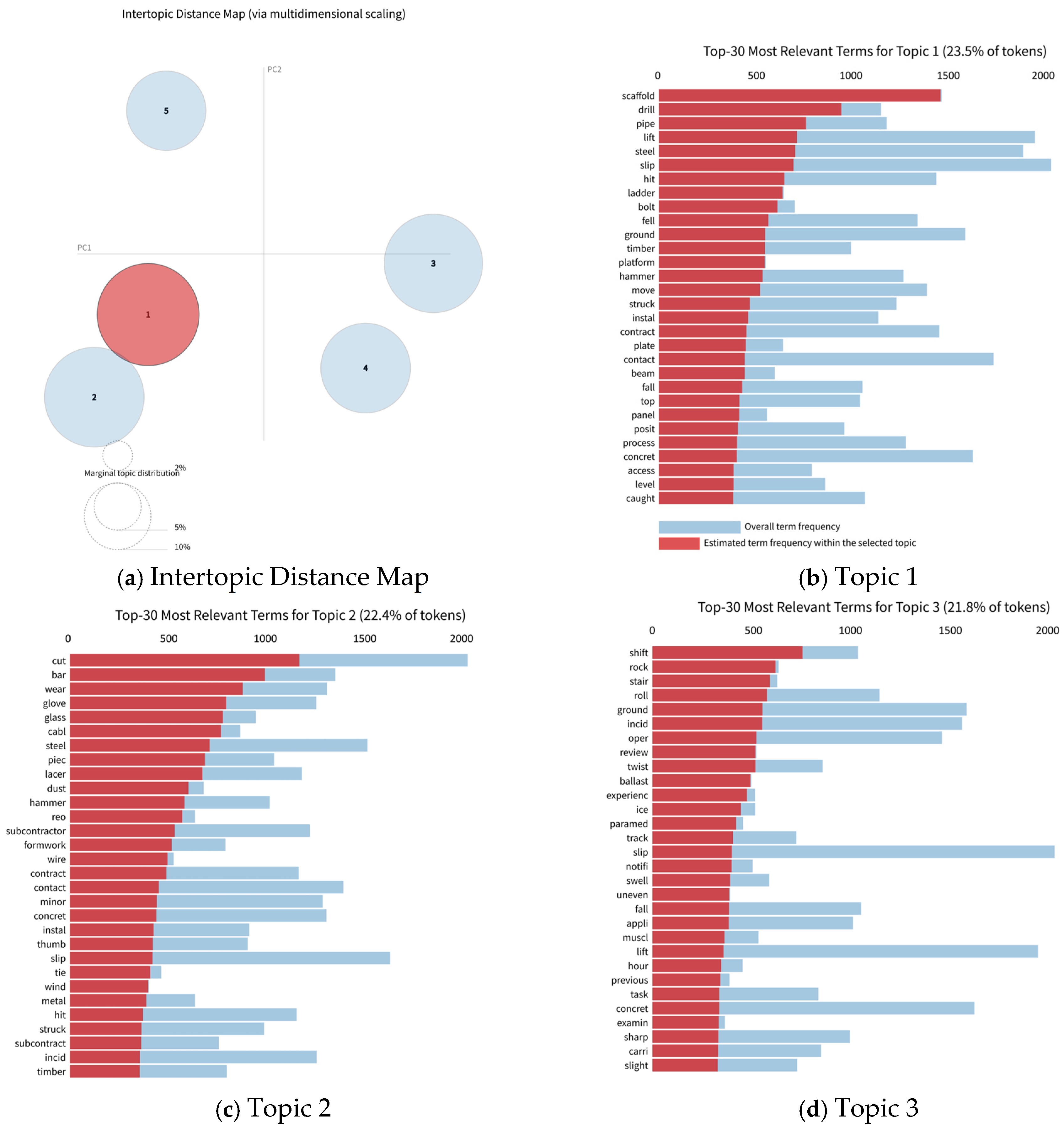
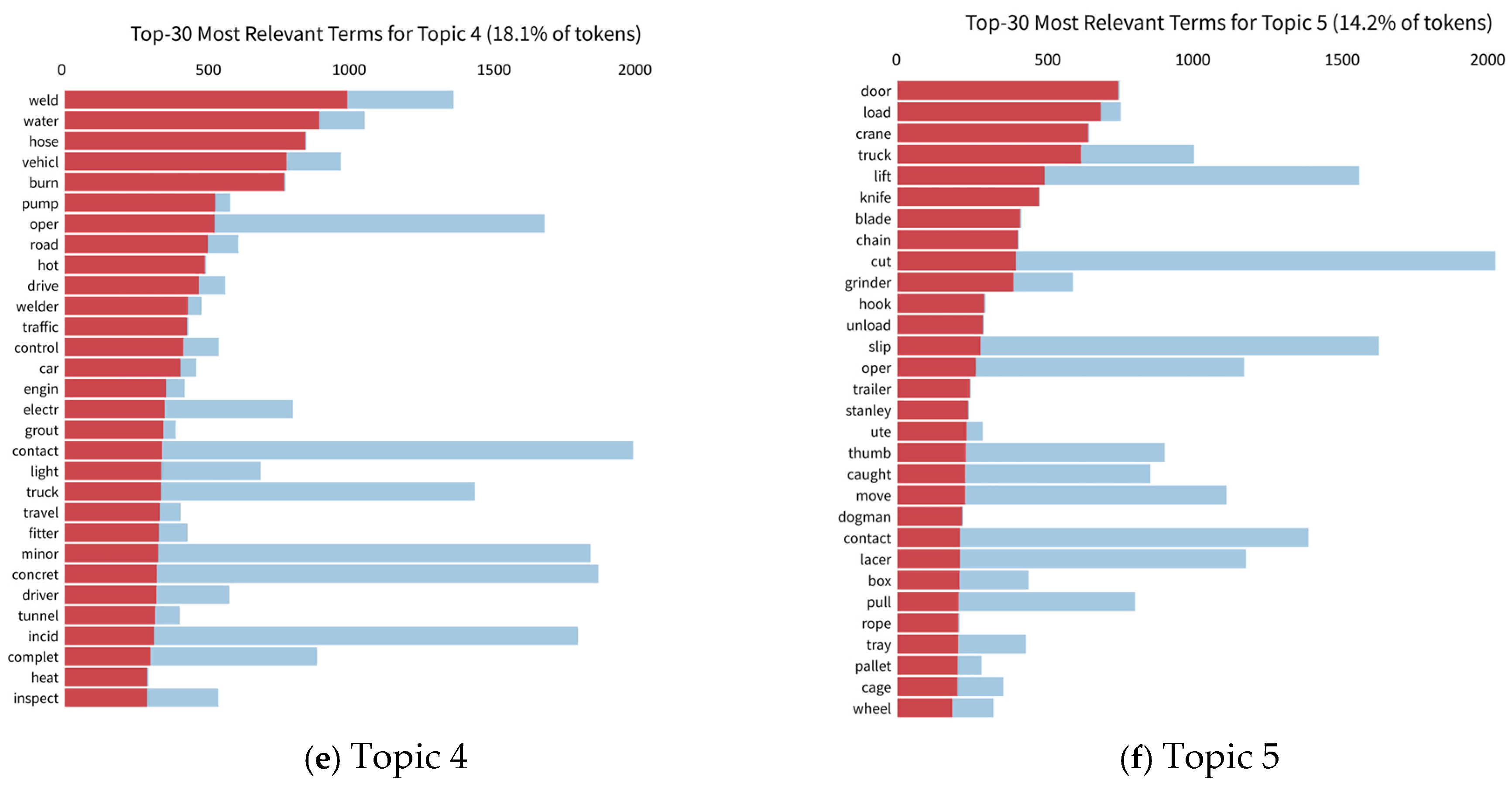
| Number of Topics | Coherence Score | Perplexity Score | Mean Intertopic Distance | Topic Similarity |
|---|---|---|---|---|
| 2 | 0.6391 | 873.6293 | 5.5552 | 0.5039 |
| 3 | 0.5984 | 1015.8064 | 4.4010 | 1.2283 |
| 4 | 0.6167 | 1282.8267 | 4.0516 | 1.4563 |
| 5 | 0.6186 | 1140.1378 | 5.3395 | 1.9337 |
| 6 | 0.6119 | 1364.5221 | 3.8384 | 3.5774 |
| 7 | 0.6214 | 1459.9610 | 3.7194 | 3.9868 |
| 8 | 0.6144 | 1551.6287 | 3.2641 | 5.0436 |
| 9 | 0.6168 | 1630.4531 | 3.7385 | 5.8385 |
| 10 | 0.5986 | 1731.4846 | 3.7452 | 6.7750 |
| 11 | 0.6055 | 1809.9245 | 3.9726 | 7.5319 |
| 12 | 0.6172 | 1905.0969 | 4.2061 | 7.7238 |
| 13 | 0.6166 | 1985.1457 | 4.5078 | 8.5683 |
| 14 | 0.6001 | 2053.0309 | 4.8993 | 8.1139 |
| 15 | 0.6014 | 2129.0086 | 5.1314 | 9.3624 |
| 16 | 0.6217 | 2186.7517 | 5.4654 | 8.3551 |
| 17 | 0.6072 | 2263.0824 | 5.7551 | 8.5070 |
| 18 | 0.6080 | 2345.2944 | 6.0608 | 9.5089 |
| 19 | 0.6137 | 2440.1065 | 6.3793 | 9.1289 |
| 20 | 0.6104 | 2511.4314 | 6.7178 | 9.4164 |
| Topic | Proportion | Number of Reports | Top-30 Most Relevant Terms (Words Are Presented in Their Root Form) |
|---|---|---|---|
| 1 | 23.5% | 4162 | scaffold, drill, pipe, lift, steel, slip, hit, ladder, bolt, fell, ground, timber, platform, hammer, move, struck, instal, contract, plate, contact, beam, fall, top, panel, posit, process, concret, access, level, caught |
| 2 | 22.4% | 3967 | cut, bar, wear, glove, glass, cabl, steel, piec, lacer, dust, hammer, reo, formwork, wire, contract, contact, minor, concret, instal, thumb, slip, tie, wind, metal, hit, struck, subcontract, incid, timber, |
| 3 | 21.8% | 3861 | shift, rock, stair, roll, ground, incid, oper, review, twist, ballast, experienc, ice, paramed, track, slip, notifi, swell, uneven, fall, appli, muscl, lift, hour, previous, task, concret, examin, sharp, carri, slight, |
| 4 | 18.1% | 3205 | weld, water, hose, vehicl, burn, pump, oper, road, hot, drive, welder, traffic, control, car, engin, electr, grout, contact, light, truck, travel, fitter, minor, concret, driver, tunnel, incid, complet, heat, inspect, |
| 5 | 14.2% | 2515 | door, load, crane, truck, lift, knife, blade, chain, cut, grinder, hook, unload, slip, oper, trailer, stanley, thumb, caught, move, dogman, contact, lacer, box, pull, rope, tray, pallet, cage, wheel |
| Topic Name | Exemplar Snippets (Anonymized) |
|---|---|
| 1. Falls from Height | Worker was descending from scaffold platform when foot missed ladder rung, fell approximately 3 m to concrete ground level, sustaining back injuries. |
| Employee stepping backwards on formwork installation lost balance and fell through opening between beams, estimated 4 m drop to lower level. | |
| While installing steel beams at height, worker slipped on wet surface and fell from edge protection, landing on material pile below. | |
| 2. Struck-by & Contact Injuries | Worker cutting rebar with grinder when cutting disc shattered, sending fragment that struck safety glasses and caused facial laceration. |
| Employee handling glass panels when sharp edge contacted bare hand through torn glove, resulting in deep cut requiring stitches. | |
| While hammering formwork ties, metal chip flew off and struck worker’s forearm, causing contusion and minor bleeding. | |
| 3. Slips, Trips, & Falls | Worker carrying materials down stairs slipped on wet patch, twisted ankle while trying to maintain balance, fell on concrete steps. |
| Employee walking across uneven ground surface tripped on loose rubble, fell forward and sustained wrist injury from impact. | |
| Operator exiting machinery cab slipped on icy step, fell to ground level and suffered muscle strain in lower back. | |
| 4. Hot Work & Vehicles Hazards | Welder performing overhead welding when hot slag fell inside collar, causing burn to neck and shoulder area. |
| Vehicle reversing in work area struck pump hose, causing pressurized hot water release that burned nearby worker’s legs. | |
| Grout pump operator contacted live electrical cable while positioning equipment near traffic route, received electrical shock. | |
| 5. Lifting & Machinery Accidents | Crane operator lifting precast panel when load shifted unexpectedly, causing chain to snap and strike ground crew member. |
| Worker using angle grinder to cut metal door frame when blade binding occurred, tool kicked back and lacerated operator’s thumb. | |
| During unloading of truck, pallet shifted on forklift tines and fell, crushing worker’s foot against loading dock edge. |
| Topic | Category | Cause | Representative Keywords | Reports with Keyword(s) (n, %) |
|---|---|---|---|---|
| 1. Falls from Height | Method | Inadequate Training & Planning [7,38,41] | scaffold, ladder, platform | 3120 (75.0%) |
| Machine | Defective/Unstable Equipment [10,40] | scaffold, ladder, platform | 3120 (75.0%) | |
| Environment | Elevated, Unprotected Workspace [3,42] | fall, height, top | 3658 (87.9%) | |
| 2. Struck-by & Contact Injuries | Man | Incorrect Tool Use/Inattention [11,41] | cut, hammer, hit | 3075 (77.5%) |
| Method | Inadequate Procedures/PPE Enforcement [10,41] | glove, cable, wire | 2895 (73.0%) | |
| Material | Sharp/Flying Objects [3,40] | bar, glass, wire | 3251 (82.0%) | |
| 3. Slips, Trips, & Falls | Environment | Unsafe Ground Conditions [3,42] | slip, ice, uneven | 3201 (82.9%) |
| Method | Poor Housekeeping & Planning [7,38] | ground, uneven, task | 2895 (75.0%) | |
| 4. Hot Work & Vehicles Hazards | Method | Lack of Controlled Work Systems [10,40] | weld, burn, traffic | 2685 (83.8%) |
| Environment | Presence of Ignition Sources/Traffic [3,42] | weld, burn, vehicl | 2805 (87.5%) | |
| 5. Lifting & Machinery Accidents | Method | Inadequate Training & Planning [7,38,41] | crane, load, oper | 1958 (77.9%) |
| Machine | Equipment Failure [40] | crane, chain, hook | 1608 (63.9%) | |
| Man | Communication Error [11,41] | signal, oper | 1432 (56.9%) |
Disclaimer/Publisher’s Note: The statements, opinions and data contained in all publications are solely those of the individual author(s) and contributor(s) and not of MDPI and/or the editor(s). MDPI and/or the editor(s) disclaim responsibility for any injury to people or property resulting from any ideas, methods, instructions or products referred to in the content. |
© 2025 by the authors. Licensee MDPI, Basel, Switzerland. This article is an open access article distributed under the terms and conditions of the Creative Commons Attribution (CC BY) license (https://creativecommons.org/licenses/by/4.0/).
Share and Cite
Wang, Y.; Zou, P.X.W. Decoding Construction Accident Causality: A Decade of Textual Reports Analyzed. Buildings 2025, 15, 3859. https://doi.org/10.3390/buildings15213859
Wang Y, Zou PXW. Decoding Construction Accident Causality: A Decade of Textual Reports Analyzed. Buildings. 2025; 15(21):3859. https://doi.org/10.3390/buildings15213859
Chicago/Turabian StyleWang, Yuelin, and Patrick X. W. Zou. 2025. "Decoding Construction Accident Causality: A Decade of Textual Reports Analyzed" Buildings 15, no. 21: 3859. https://doi.org/10.3390/buildings15213859
APA StyleWang, Y., & Zou, P. X. W. (2025). Decoding Construction Accident Causality: A Decade of Textual Reports Analyzed. Buildings, 15(21), 3859. https://doi.org/10.3390/buildings15213859







